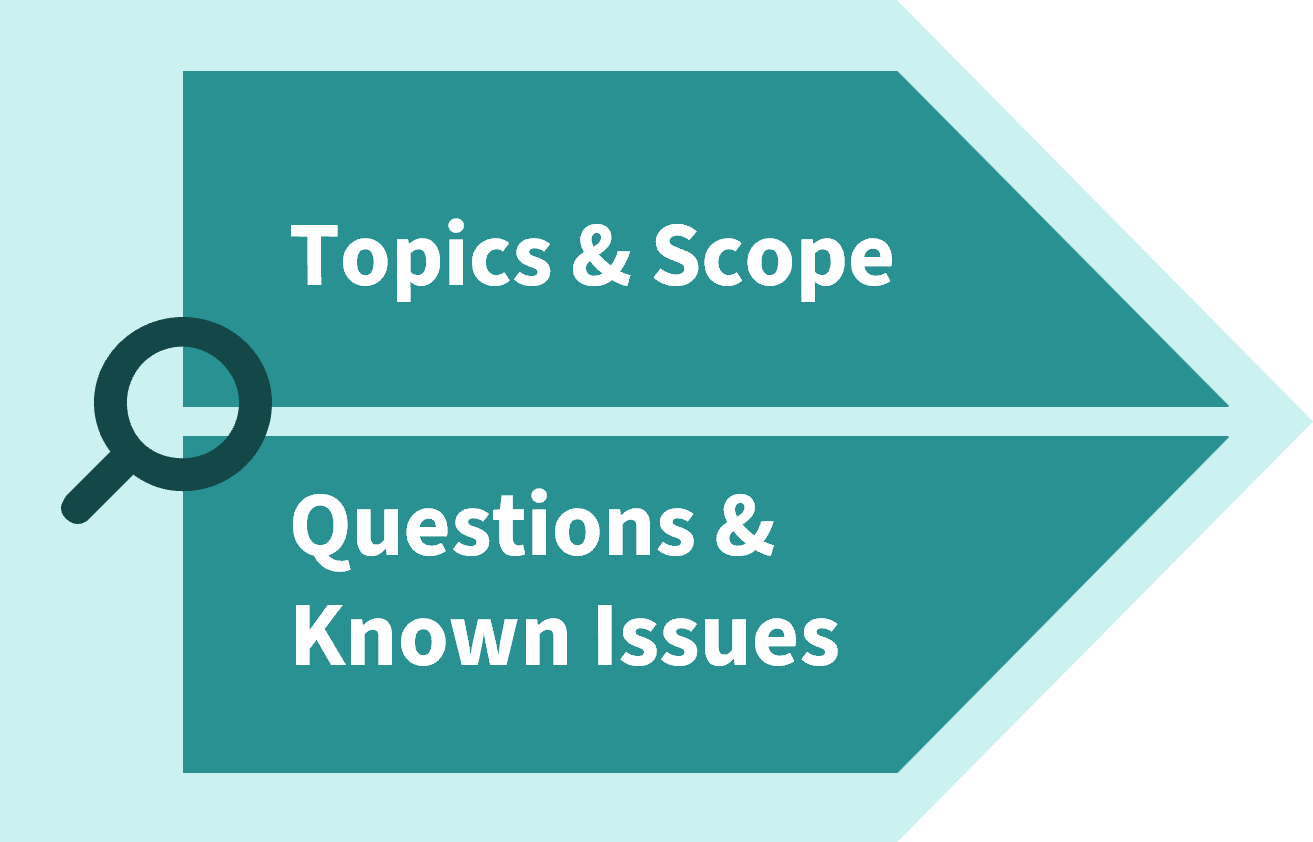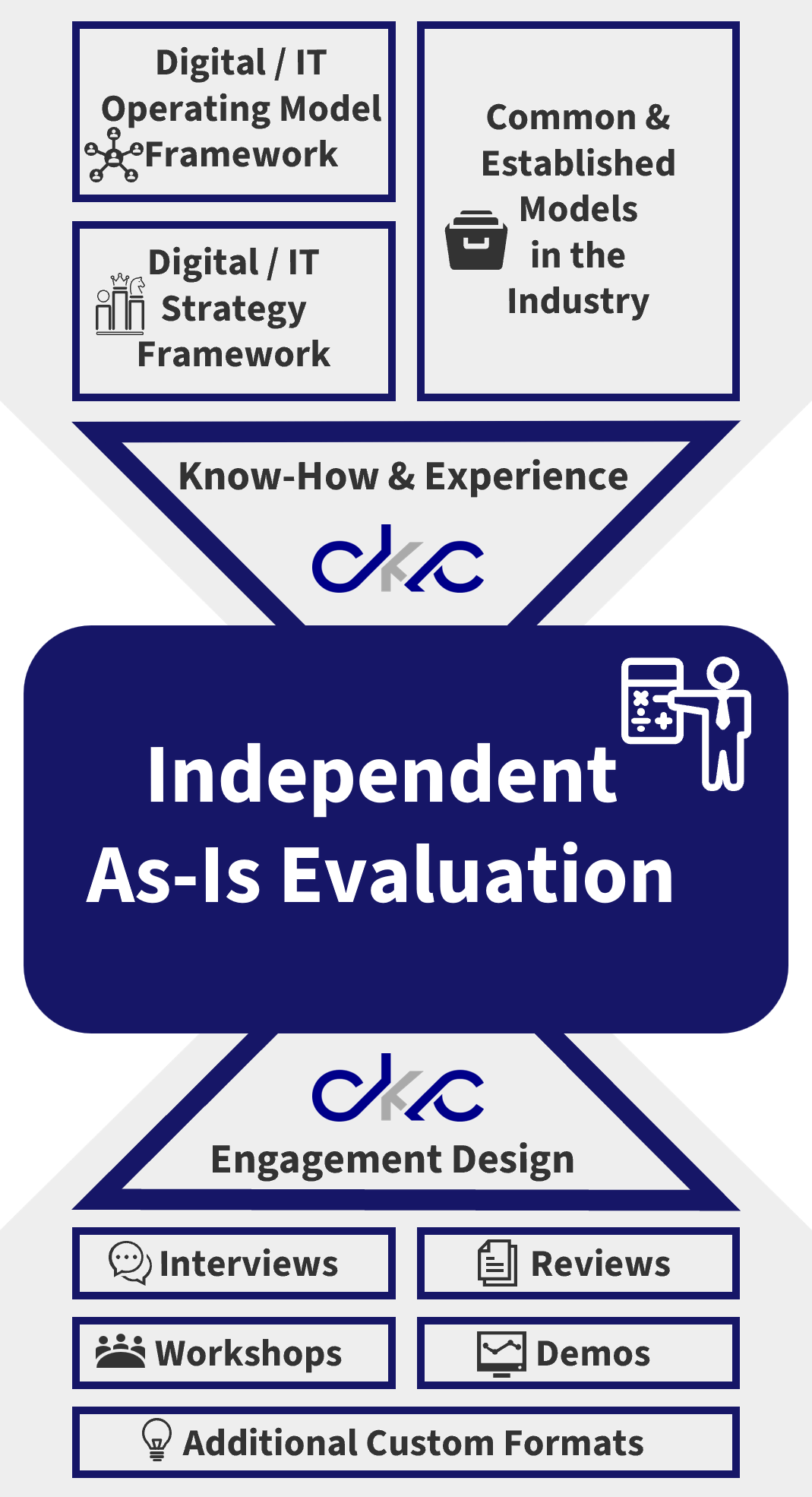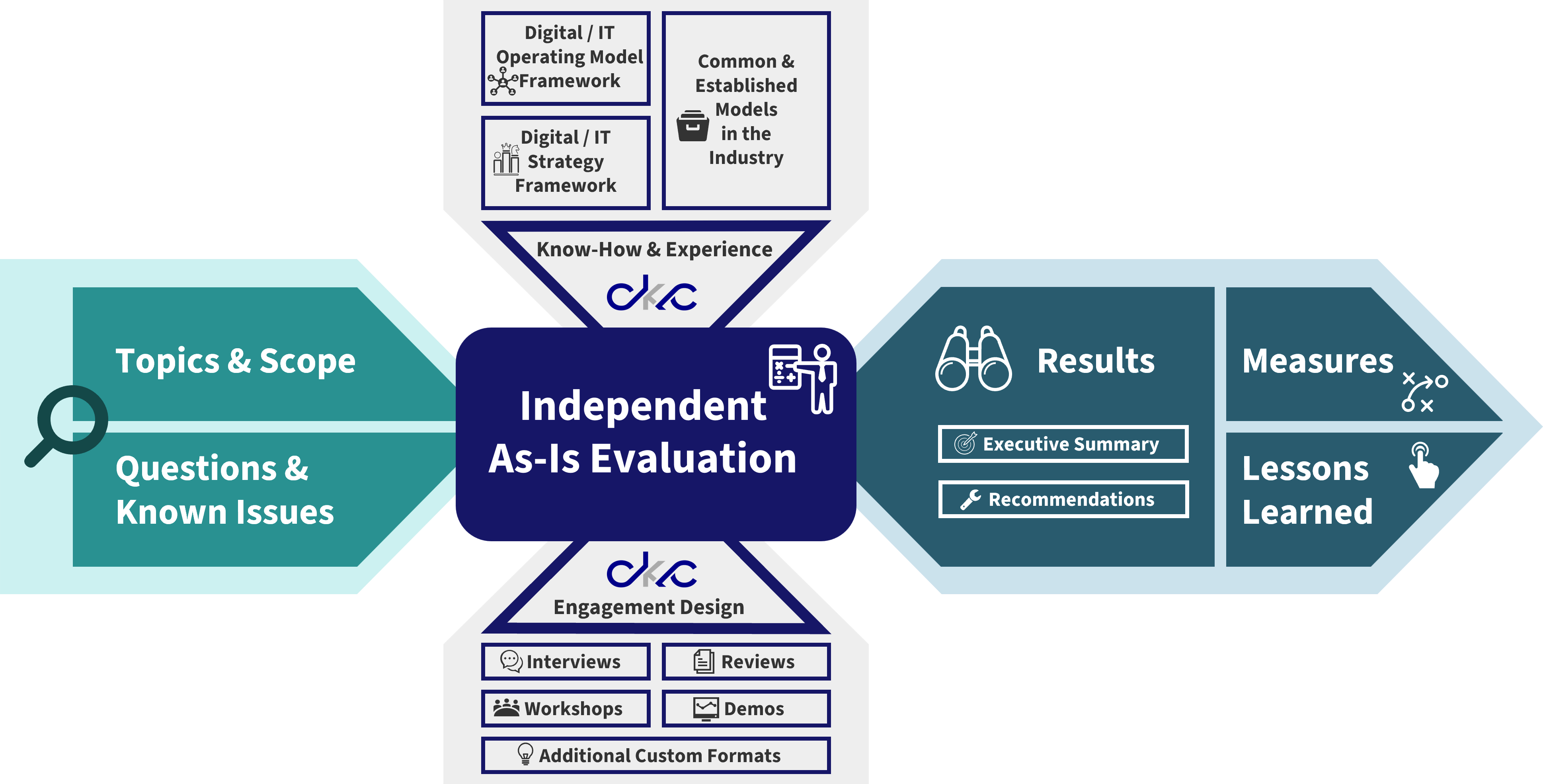Capabilities to read between the lines and put technical results into the strategic context of the corporation.
CKC - Independent As-Is Evaluation
While an independent as-is evaluation alone is less often mandated, it is a primary ingredient in many consulting projects concerning strategy and organization in the digital / IT area. Christian Kaliauer has performed these types of analyses with clients in various scenarios and industries. Several patterns have emerged in these engagements. Depending on the actual focus topics, CKC defines a carefully tailored approach based on long-time experience, applicable CKC frameworks, and typical methods established in the market (e.g., ITIL, SAFe Maturity Models, etc.).
Utilizing an Independent As-Is Evaluation brings the Following Benefits to Our Clients
Let's dive into the As-Is Evaluation Framework
The as-is analysis
is the determination of the current situation
for a specific scope and defined focus points
by utilizing specific methods and frameworks
while balancing resource investment and the level of detail
to bring the results in a compact format
understandable for the specified key stakeholders
as a foundation to derive measures for the future
and to act as input to strategic projects
from the perspective of a neutral, experienced external position.
There are various triggers for an as-is evaluation. With our clients, we typically see the following scenarios:
- Stand-alone as-is evaluation for critical topics where an external assessment is beneficial to make a better and more informed decision on the next steps
- As-is evaluation as part of a Digital / IT strategy development
- to derive conclusions on the as-is
- to understand the ambition level of the target state development
- to support roadmap planning
- As-is evaluation as part of a Digital / IT operating model development
- to derive conclusions on the as-is
- to understand the ambition level of the target state development
- to support roadmap planning
- As-is evaluation as part of a Digital / IT due diligence engagements in M&A-related scenarios
- to understand the current situation of the digital / IT function of the target corporation
- to identify potential red flags
- to provide specific content that can be utilized in the contract creation and deal negotiations
- As-is evaluation to establish a joint basis in specific coaching situations
- As-is evaluation to work on and resolve special strategic topics
Phase 1 of the as-is evaluation:
The alignment on scope, focus topics, questions and known issues in the beginning is essential for the success of the external review.
 Topics & Scope
Topics & Scope
• Defined scope
• Defined topics
• Defined level of detail(s)
• Explicit non-targets
Questions & Known Issues
• Key questions towards the evaluation
• Outline known issues
Phase 2 of the as-is evaluation
The value of our as-is evaluation is strongly based on our know-how and experience gained over many years derived from many scenarios. For the specific setting and defined goals (Phase 1), we bring a set of frameworks and tailor the engagement design to your individual situation.

Structuring our know-how and experience around frameworks & models:
• CKC Digital / IT Operating Model Framework
• CKC Digital / IT Strategy Framework
• Established frameworks such as ITIL, PMI, SCRUM, SAFe, CoBIT, Business Process Management, Lean, Six Sigma
• Selection of the frameworks based on the outcomes of Phase 1
We define a specific and tailored custom engagement design out of a set of tools & techniques:
• Interviews with key stakeholders and personnel
• Reviews of documents and available information
• Workshops to interact and dig into more complex topics
• Demos to "touch & feel" the specific environment
• Additional custom formats depending on the outcomes of Phase 1
We regard a couple of factors as especially important for a successful independent as-is evaluation:
• Provision of all relevant documents to the evaluation team - from technical documents up to specific reports and decision papers for the top management
• Pro-active identification of all key stakeholders and personnel to derive a representative interview partner list
• Availability of all identified interview partners and key personnel
• Open communication on historical aspects and open discussions regarding the central scope of the evaluation
• Any previous attempts and results of a performed internal or external review
Phase 3 of the as-is evaluation
When the as-is evaluation is properly set up, design and executed (phase 1 + 2), the results of such a review will be meaningful and will assist decision making and deriving next steps.
 Results (retrospective)
Results (retrospective)
• Report with the defined aspects
• Executive summary
• Recommendations
Measures (forward looking)
Lessons Learned (forward looking)
Phase 3 is typically structured two-fold.
Part 1 as a retrospective - When we perform an as-is evaluation for one of our clients, our results will consist of a detailed report aligned to the agreed scope and the engagement design. In addition, we provide an executive summary tailored to the stakeholder audience and recommendations from our external and independent perspective to improve the situation.
Part 2 as a forward-looking call to action - On the client side, the organization should derive actual measures and lessons learned based on the findings and recommendations of the as-is evaluation. Furthermore, we propose that the client derive lessons learned that should be incorporated into the organization's guidelines and processes. We are happy to assist this part 2 but want to point out that the execution of part 2 falls under the client's accountability for good reasons.

Although as-is evaluations are a classic engagement type performed on the market for many years, some typical lapses and shortcomings can occur. We are focused on minimizing the potential for deficiencies and improving the value and process quality of such an as-is evaluation by stringently applying our three-phase model and our identified success factors.
- Phase 1: Setting the stage
- Define topics & scope
- Define the audience of the evaluation report
- Bring up key questions and known issues
- Phase 2: Perform the as-is evaluation
- Design the engagement properly to the defined scope and goals
- Be aware of the critical success factors and act accordingly
- Utilize experience and frameworks
- balance efforts and expected gain of knowledge by a proper set of interviews, workshops, reviews, demos, and further custom methods
- Phase 3: Present and interpret the results
- Retrospective: understand the results represented by the executive summary and recommendations
- Forward-looking: define and execute measures; incorporate lessons learned into your organization's guidelines and processes
Q: You are talking about the importance of performing an as-is evaluation during strategy development projects - what happens if I skip this phase?
CKC: From time to time, we hear arguments for skipping the as-is evaluation, such as speeding up the project, saving resources, and that the client is anyway aware of his as-is situation. There are a few typical problems and issues that you encounter when you skip this phase:
- No clear baseline to map the strategic target pictures against and derive initiatives for the strategic roadmap
- A lot of implicit knowledge and superficial knowledge; stakeholders have different gut feelings; depending on the interest group, (very) different opinions on status, strengths, weaknesses, and vision
- From an external view, this implicit knowledge and the different variants of the as-is situation are very hard to get a gripping one. Following this, there is a great tendency in the project to stay at the "buzzword level" without an objective discussion in more detail on the actual pain points. In other words: Every outcome is valid, as you can pick your version of the as-is situation as an argumentative basis to support this specific outcome.
A better approach is to have a thorough scoping and project design to maximize the outcome and benefit from the advantages of a well-performed as-is evaluation if there are concerns on the client's side about the length and necessity of the as-is evaluation. Our 3 phases model helps to go through this process.
Q: Are you working with maturity models? If so, how detailed are they?
CKC: We are very selective in applying maturity models. In our daily work, we have seen multiple maturity models containing only part of the truth. Some executives lean very much on maturity scores and are eager to improve these values. Eventually, even in little steps in the decimal place. Further complexity in maturity models and the eventual comparison against a time series is that the maturity levels have to be potentially adjusted over the years. Best practices and implementation levels in the peer group evolve - especially in such a dynamic area as the area of digital / IT.
Therefore we like to work with qualitative statements and identified focus topics. This way we can discuss more subtle elements and dependencies with more clarity. Still, utilizing maturity models as context or displaying key results in a typical format also used by maturity models allows to bring stakeholder groups on board and guide the discussion towards the most critical topics.
If you are interested in applying a specific maturity model and discussing the pros and cons, we are happy to discuss this specifically with you in further detail.
